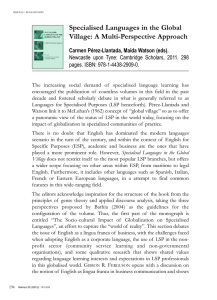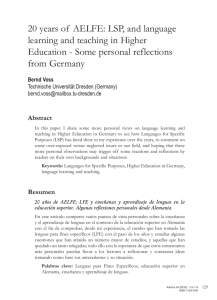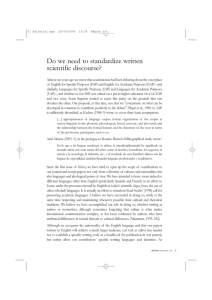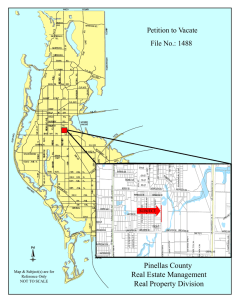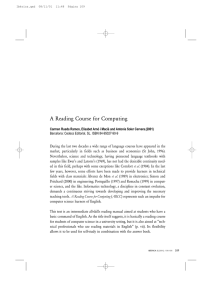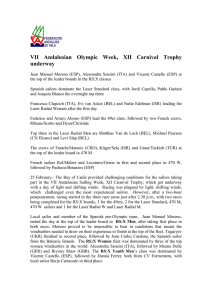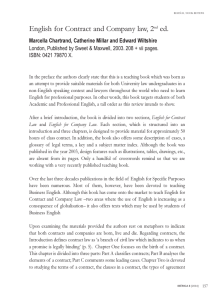LSP at 50: Looking back, looking forward
Anuncio
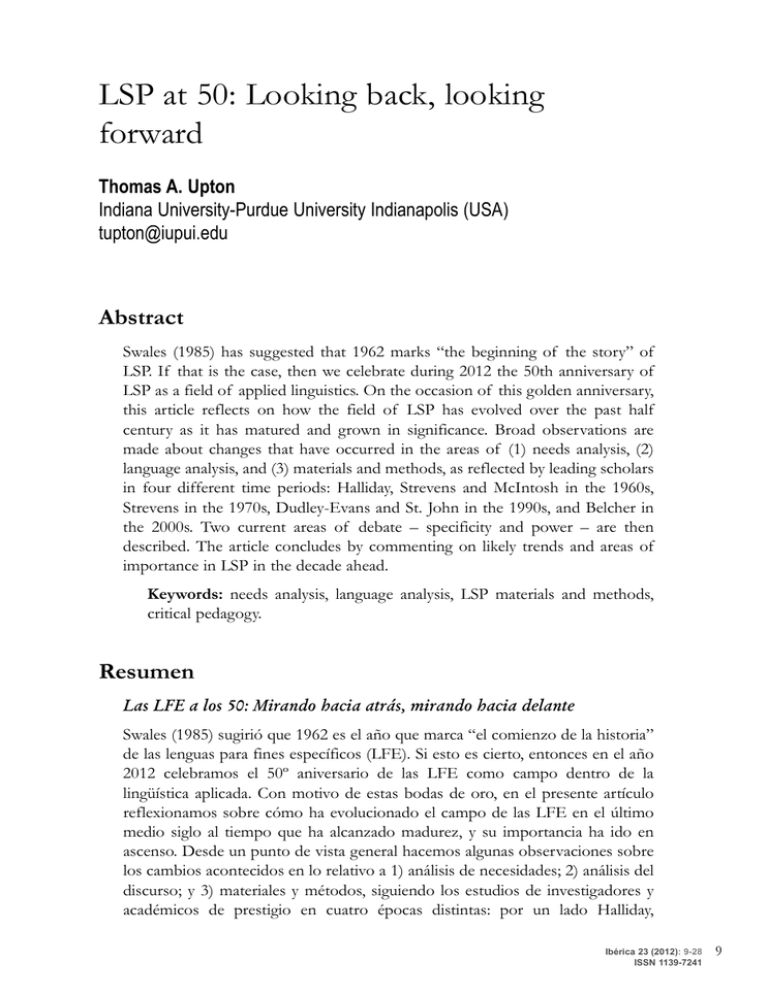
LSP at 50: Looking back, looking forward Thomas A. Upton Indiana University-Purdue University Indianapolis (USA) tupton@iupui.edu Abstract Swales (1985) has suggested that 1962 marks “the beginning of the story” of LSP. If that is the case, then we celebrate during 2012 the 50th anniversary of LSP as a field of applied linguistics. On the occasion of this golden anniversary, this article reflects on how the field of LSP has evolved over the past half century as it has matured and grown in significance. Broad observations are made about changes that have occurred in the areas of (1) needs analysis, (2) language analysis, and (3) materials and methods, as reflected by leading scholars in four different time periods: Halliday, Strevens and McIntosh in the 1960s, Strevens in the 1970s, Dudley-Evans and St. John in the 1990s, and Belcher in the 2000s. Two current areas of debate – specificity and power – are then described. The article concludes by commenting on likely trends and areas of importance in LSP in the decade ahead. Keywords: needs analysis, language analysis, LSP materials and methods, critical pedagogy. Resumen Las LFE a los 50: Mirando hacia atrás, mirando hacia delante Swales (1985) sugirió que 1962 es el año que marca “el comienzo de la historia” de las lenguas para fines específicos (LFE). Si esto es cierto, entonces en el año 2012 celebramos el 50º aniversario de las LFE como campo dentro de la lingüística aplicada. Con motivo de estas bodas de oro, en el presente artículo reflexionamos sobre cómo ha evolucionado el campo de las LFE en el último medio siglo al tiempo que ha alcanzado madurez, y su importancia ha ido en ascenso. Desde un punto de vista general hacemos algunas observaciones sobre los cambios acontecidos en lo relativo a 1) análisis de necesidades; 2) análisis del discurso; y 3) materiales y métodos, siguiendo los estudios de investigadores y académicos de prestigio en cuatro épocas distintas: por un lado Halliday, Ibérica 23 (2012): 9-28 ISSN 1139-7241 9 THOMAS A. UPTOn Strevens y McIntosh en los años 60, Strevens en los 70, Dudley-Evans y St. John en los 90, y Belcher en la primera década del 2000. Seguidamente describimos dos cuestiones que en la actualidad se prestan a discusión y debate: especificidad y poder. Para concluir, estudiamos las posibles tendencias y áreas de las LFE que pueden llegar a resultar significativas en la próxima década. Palabras clave: análisis de necesidades, análisis del discurso, materiales y métodos en LFE, pedagogía crítica. The rise of LSP as a field of applied linguistics Strevens (1977: 150-151) places the historical roots of “specific-purpose language teaching” (SP-LT), with language instruction as the primary focus rather than professional or occupational skills, in the early 1900s with the development of courses for international travel. These courses, though, typically did not require – nor even expect – any real development of second language proficiency. It was during World War II that specific purposes language instruction gained increased interest as many of the world militaries established, as Strevens (1977: 151) describes it, “massive programmes of SP-LT” in support of espionage efforts; he gives the example of Royal Air Force personnel who learned Japanese solely for the purpose of (a) listening, in the Burmese jungle, to Japanese fighter aircraft talking to their ground control stations, (b) identifying their targets, and (c) using this information to alert RAF interceptor fighters. These students of Japanese never learned to read or write the language, but they achieved the requisite listening-only command of this restricted form of the language in a matter of a few weeks of intensive learning. In many respects these war-time foreign language programs were not so different from the “Spanish for Tourists” courses of the early 1900s in that there was little theoretical underpinning guiding the exploration of what language was used, how it was used, for what purposes it was used, and what students’ needs were as learners and users of the language – all necessary characteristics of true LSP instruction. In the years after World War II enormous social changes and massive economic development took place on a global level. Europe and Japan worked to rebuild themselves, and newly independent countries across Asia and Africa looked to modernize their economies (Kumaravadivelu, 2006a). This global push to rebuild and modernize opened the door to explosive 10 Ibérica 23 (2012): 9-28 LSP AT 50 growth of multinational business and trade, and was coupled with a vision for peaceful internationalization by organizations such as the United nations seeking to promote diplomacy, international communication and student exchanges (Hutchinson & Waters, 1987). It is during this fertile post-war period of the early 1960s that LSP is commonly recognized as being established as a field of applied linguistics (see, for example, Robinson, 1980; Swales, 2000). While Swales (1985: x) opined that LSP “has no clear and indisputable beginning”, he suggests that Barber’s (1962) article, “Some measurable characteristics of modern scientific prose”, qualifies as the beginning of the LSP story as this was the first study to clearly demonstrate that descriptive linguistics can be used to analyze the language of science and technology, persuasively showing that “scientific” English differed in important ways from “general” English. While Barber’s (1962) article may represent LSP’s beginning and promise, it was Halliday, McIntosh and Strevens who in their 1964 book, according to Swales (2000), provide the theoretical foundation for LSP as a distinct field of study and not simply as an instructional endeavor: Only the merest fraction of investigation has yet been carried out into just what parts of a conventional course in English are needed by, let us say, power station engineers in India, or police inspectors in nigeria; even less is known about precisely what extra specialized material is required. This is one of the tasks for which linguistics must be called in. Every one of these specialized needs requires, before it can be met by appropriate teaching materials, detailed studies of restricted languages and special registers carried out on the basis of large samples of the language used by the particular persons concerned. (Halliday, McIntosh & Strevens, 1964: 189-190) As Swales (2000: 59-60) describes it, this passage established the following agenda for LSP analysis and instruction: (1) Research into language use should be descriptive, looking at what kind of language is used in particular contexts and how it is used; (2) The real language used by regular people (not famous or literary figures) should be the focus of analysis; (3) Current, everyday language is of primary importance; (4) Language as it is spoken or written in specific contexts should be the focus of study (not “authorial motives for linguistic choices”); and (5) There should be an analysis of functional grammar along with the contextual factors that influence language use. Ibérica 23 (2012): 9-28 11 THOMAS A. UPTOn In the words of Hutchinson and Waters (1987: 7), reflecting on early studies of language use, “The idea was simple: if language varies from one situation of use to another, it should be possible to determine the [language] features of specific situations and then make these features the basis of the learners’ course”. If Barber’s 1962 article (nourished, if you will, by the contributions of others in the early 1960s) marks LSP’s birth, then we celebrate during 2012 the 50th anniversary of LSP as a field of applied linguistics. As we often do on “golden anniversaries”, this seems a meaningful point in time to stop and reflect on where we have come from as a field, what current issues we are still wrestling with, and what trends are likely to be a part of the future. In short, how has the field of LSP evolved as it has matured and grown in significance over the past half century? ESP: The “Tyrannosaurus Rex” in the room Before addressing the question just posed, it is important to insert a disclaimer into a piece such as this that strives to provide an overview of the field of LSP: While the study of LSP can encompass any language used in the world, the vast majority of the language analysis and instruction (and publication!) that has been done in LSP over the past 50 years has focused on English. Consequently, the terms English for Specific Purposes (ESP) and LSP are often used interchangeably (Belcher, 2009), and even in this article on LSP much of the scholarship cited focuses on ESP. The dominance of ESP is reflected by the fact that two of the leading journals in LSP are titled English for Specific Purposes: An International Research Journal and Journal of English for Academic Purposes. The dominance of ESP is even seen in Ibérica, the leading international journal with the broader of focus on LSP; for example, in four recent issues (Fall 2009 – Spring 2011), the journal published 27 scholarly articles of which 23 (85%) dealt – wholly or in part – with ESP topics while only 4 (15%) focused exclusively on languages other than English. Swales (2000) acknowledges the dominance of English in his article reviewing the field of LSP in a section titled English English Everywhere: “One of the ironies of the emergent field of ESP is that its very success in catering to the needs of nonnative speakers has contributed to the overpowering position of English in today’s worlds of sciences, scholarship, and business” 12 Ibérica 23 (2012): 9-28 LSP AT 50 (Swales, 2000: 67). In an earlier article, Swales (1997: 374) likened English in the realm of academia to a Tyrannosaurus Rex, “a powerful carnivore gobbling up the other denizens of the academic linguistic grazing grounds”. Some would argue that it is a bit disingenuous to attribute the dominance of ESP primarily to the efficacy of instruction. Hutchinson and Waters (1987), among others, explain the dramatic rise of ESP as directly related to the international oil crisis of the early 1970s, which resulted in Western money and knowledge – primarily British and American – flowing into oil-rich countries. The language of this knowledge was English. Benesch (2001: 31) provides what she calls an overview of “ESP’s unofficial history” in which she persuasively shows that “ESP did not develop inevitably and naturally”; in fact, she argues that the dominance of ESP is a direct result of “the conscious planning on the part of industry, aided by governments, foundations, and academic institutions working together to shore up markets in developing countries”. Her point, which will be revisited below, is that ESP – and LSP in general, for that matter – is a political and economic endeavor as much as it is a language-teaching one. In short, the emphasis in LSP on the analysis and teaching of English is because in many cases English is by far the most prominent language that non-native speakers are wanting, needing or expected to learn in particular contexts, and this has everything to do with power and money. BocanegraValle’s (forthcoming – 2012) article on “Maritime English” illustrates this well. The shipping trade is global and even one shipment typically involves many countries, languages, and cultures. Bocanegra-Valle gives the example of one ship that “was built in Spain, had a norwegian owner, was registered in Cyprus, was managed from Glasgow, was chartered by a French company, had a Russian crew, was flying a Liberian flag, and carried American cargo”. In this international context, English is the common language of the high seas. While ESP has led the way in the field of LSP to date, the future is bright for other languages. For example, Spanish, which has long been an important language of LSP in Europe, no doubt will continue to grow in importance with the economic and political development of Spanish-speaking countries in Central and South America (Sánchez-López, 2010). And with the economic and military rise of China, and the growing international reach of Arabic-speaking countries, Chinese and Arabic are also likely to grow in importance in the field of LSP in the years ahead (Kanoksilapatham, forthcoming – 2012). Ibérica 23 (2012): 9-28 13 THOMAS A. UPTOn LSP then and now: A reflective overview One way to provide an overview of the changing trends and focuses of LSP over the past fifty years is to look at how leading scholars have described LSP in three key areas: (1) needs analysis; (2) language analysis; and (3) materials and methodology. Picking representative perspectives from different time periods is an individual choice, but most would not argue that leading thinkers in LSP – and specifically ESP – include Halliday, Strevens and McIntosh in the 1960s, Strevens in the 1970s, Dudley Evans and St. John in the 1990s, and Belcher in the 2000s1. Table 1 summarizes the perspectives that each has given in these three areas in their published work, and from this several broad observations can be made that will structure the discussion for the rest of this paper. Halliday, Strevens & McIntosh Strevens (1977: 150) Dudley Evans & St. John Belcher (2004, 2009) (1998: 4) (1964: 189) Needs Identify the “specialized” language used in specific contexts that learners need to know Focus on “languageusing purposes of the learner” “Designed to meet specific needs of the learner”, including wants, skill/ knowledge gaps, etc. “First and foremost (before, during, and even after instruction) finding out what learner needs are” (2009: 3) Language Analysis “Detailed studies of restricted languages and special registers (…) used by the particular persons concerned” Focus on “communicative needs” and “language-using purposes” that are restricted (by vocabulary, language skills, themes, etc.) to those “required by the learner’s purposes” “Centred on the language (grammar, lexis, register), skills, discourse and genres appropriate to these activities” Emphasis on “socialsituatedness” of language use (2004: 166); understanding of language use in specific contexts is essential – using a variety of analyses Materials & Methods Determine “appropriate” and “extra specialized” teaching materials Use of methodology “appropriate to the learning/teaching situation” “Makes use of the underlying methodology and activities of the disciplines it serves” “Developing or adapting materials and methods to enable needsresponsive instruction” (2009: 3) Focus Words and structures Texts and purposes Learners and genres Contexts and interactions Table 1. Fifty years of evolving LSP theory as reflected by leading scholars. N N 14 Ibérica 23 (2012): 9-28 LSP AT 50 Needs analysis needs analysis – or needs assessment – has from the start been identified as a defining characteristic of LSP (for example, Johns & Dudley-Evans, 1991; Basturkmen & Elder, 2004). However, what is considered important to focus on in the needs analysis has evolved significantly through the years. Halliday, McIntosh and Strevens (1964) highlighted the importance of identifying the “specialized” language used in specific contexts that learners need to know. As reflected in their book and others of that time period, specialized language was understood primarily as the grammar and vocabulary that are distinct for that context, and thus the needs assessment primarily focused on sentence patterns and key vocabulary. Herbert’s (1965) book, The Structure of Technical English, a contemporary to Halliday, McIntosh and Strevens’, and which Swales (1985: 17) identifies as “the first ‘real’ ESP textbook”, is an excellent example of this structural emphasis. In his discussion of the importance of Herbert’s book, Swales notes that its focus is solely on presenting the sentence patterns and vocabulary that are particular to technical English texts. By the 1970s, there is a noticeable shift from a simple focus on language structures to a broader goal of understanding the “language-using purposes of the learner”, with the goal being to meet “the requirements of the learner” (Strevens, 1977: 146, 150). That is, while structures and vocabulary are still of importance, it was now recognized that these must be examined in light of how individual learners will need to use them. This shift in focus parallels broader changes going on at the time in educational psychology, and in second language education in particular, when there was growing recognition of the importance of language as a tool for communication by individuals. Along with the broader communicative language learning movement, LSP also moved towards a more learner-centered focus, including the recognition that individual students have different needs and interests, and that these differences influenced not only students’ motivation to learn, but also the effectiveness of their learning. This focus on identifying the “specific needs of the learner” (Dudley-Evans & St. John, 1998: x) – as opposed to simply focusing on the language used in specific contexts – has carried forward through the 1990s to the present. There is, however, a notable change in the expectations of the needs assessment. The needs analyses of the 1970s and 1980s tended to focus on the situations, functions, tasks and/or skills students needed in the target Ibérica 23 (2012): 9-28 15 THOMAS A. UPTOn situation (West, 1997). By the 1990s, the scope of the needs assessment began to expand to include personal and professional information about learners (including wants, preferences and aspirations), learners’ needs and lacks, and even “means analysis” – information about the learning context (Dudley-Evans & St. John, 1998). The needs assessment as the basis for determining the syllabus for the specific context under consideration continues to be of primary importance in LSP. Along with the developments highlighted above, the needs assessment is now more than ever seen as an on-going process, not a oneand-done event that never needs to be revisited. Belcher (2009: 3) articulates this perspective in her belief that all of LSP/ESP is united by a commitment to the purposes of the learners as reflected by “first and foremost (before, during, and even after instruction), finding out what learners’ needs are”. To summarize, while needs analysis has from the beginning been central to the field of LSP, our understanding of what the needs analysis entails has evolved markedly over the past fifty years. Our focus has shifted from a simple, one-time pre-course evaluation of the grammar and vocabulary that are distinct for specific language contexts, to thick, on-going descriptions of the full range of language structures and communicative purposes that particular students need that also take into account learner characteristics and the teaching context (see Table 1: needs). Language analysis One of the cornerstones of LSP is the analysis of language and language use in order to inform teaching. As mentioned above, the early focus in LSP was the vocabulary and language structures used in specialized contexts – “register analysis”. Early register analysis had to be done by hand, so typically focused on (often pre-determined) features that could be identified and counted using a fairly small corpus of texts. The goal, of course, was to highlight key language features that could then be taught to LSP learners (Halliday, McIntosh & Strevens, 1964). Unfortunately, this approach isolated the language features from the context, resulting in reading passages that lacked authenticity and communicative purpose. LSP textbooks based on register analysis (almost exclusively focusing on scientific English) “left a lot to be desired” as the pedagogical application was out of step with the educational changes occurring in the 1970s (Dudley-Evans & St. John, 1998: 21). 16 Ibérica 23 (2012): 9-28 LSP AT 50 The primary critique of early register analysis was that it focused on language use at the sentence level. By the 1970s, discourse analysis – with the focus on the rhetorical structures and purposes at the discourse level – became the primary tool of LSP language analysis. Broadly speaking, the goal of discourse analysis is to examine the language structures and patterns that are distinctive of and create meaning for texts as a whole. A key advantage of LSP materials developed from discourse analysis is that it helps students to focus on how language is used to accomplish different rhetorical purposes within texts/contexts rather than simply on learning correct grammar; in keeping with broader educational shifts, the focus turned more to the importance of communication (Strevens, 1977). In the 1980s, there was a growing emphasis on language use and functions in specific text types, called “genres” in recognition of the rhetorical characteristics these texts have. Swales (1990) is most closely identified with early efforts in genre analysis (a type of discourse analysis) as he developed a method for analyzing the shifting communicative purposes, called “rhetorical moves”, in a text. His analyses of research article introductions showed how scientists organize their texts in specific and fairly predictable ways in order to establish the context in relationship to previous research, credibility for their own research, and the purpose for the study they are presenting; importantly, these rhetorical moves can be taught to novices of that genre. As popular as genre analysis proved to be, questions began to be raised about how broadly genre-research findings could be applied. Prior (1995), for example, challenged a key assumption that the text types that make up genres are predictable and stable across and within disciplines, at least within the EAP context. Prior (1995: 76-77) found academic discourse and academic environments instead to be “complex, constructed and unfolding events and not closed systems susceptible to taxonomic and rule-oriented description”. Today, there is a clear understanding that genre is “more contextual than simply textual, dynamic than static, varied than monolithic, and interesting in its shaping of and being shaped by people” (Belcher, 2006: 142). The result is that language analysis now has a much stronger emphasis on the social situatedness (the context) of the text, and the influence that has on meaning and rhetorical purposes. The types of analyses used today to understand language purposes, structures and uses are more varied and complex than the brief overview Ibérica 23 (2012): 9-28 17 THOMAS A. UPTOn above might suggest. What is important to note is the change in perspective that has occurred over the past fifty years (see Table 1: Language Analysis). Sensitivity to language in context has always been an underlying strength of LSP, but what is meant by context has evolved and, thus, the types of language analyses emphasized have also evolved. Early on, the task was simply enumerating and describing linguistic features, primarily vocabulary and grammar, in the context of the sentence (Halliday, McIntosh & Strevens, 1964). In the 1970s and 1980s the focus shifted to broader concern at the discourse level with language structure, use and functions in specific text types for particular purposes (Strevens, 1977). Genre analysis focused the attention on the writer’s purpose, and how rhetorical considerations impact grammatical choices (Dudley-Evans & St. John, 1998). More recently, there has been greater acknowledgement that language is all about discourse and the social construction of knowledge, and thus there is growing recognition that the study of social practices must be integral to LSP research and teaching (Belcher, 2004). In short, language analysis over the past 50 years has moved from simply the study of chunks of isolated texts (i.e., language products) to a broader examination of how whole texts – and contexts, including authors/speakers and intended audiences – interact with and influence each other, with attention now focusing on more context-specific texts and the communication strategies that are used to engage the audience. LSP has evolved, too, from simply detailing differences to understanding and explaining the differences between the language features used in different contexts. Materials and methods As observed by Swales (2000: 60), Halliday, McIntosh and Strevens’ (1964) foundational book “offered a simple relationship between linguistic analysis and pedagogic materials”. The teacher’s role, according to Halliday, McIntosh and Strevens (1964: 189, 190), is to determine “appropriate” and “specialized teaching materials” that could be used to teach the language structures and vocabulary. The educational and pedagogical sea changes that occurred in the 1960s and 1970s, and in particular the move toward communicative language learning and the needs of individual learners, also influenced LSP materials and methods in at least two important ways. First was the push for “authentic” 18 Ibérica 23 (2012): 9-28 LSP AT 50 materials that reflect the contexts and uses of the language in the specific context. As Coffey (1985: 84) frames it: “The main consideration in ESP exercise typology must be that of authenticity. All ESP work is in essence a simulation of a real-life task”. It did not take long to realize that the strength of the LSP approach, the focused attention on the language needs in specialized and specific contexts, also proved to be a weakness. As Strevens (1977: 159) noted in the 1970s, “the biggest problem is the shortage of usable textbooks, readers, etc., for any given speciality”. The underlying necessity for context-specific materials as the basis for the LSP classroom led to the observation by several that LSP instruction has tended to be materials driven (e.g., Johns & Dudley-Evans, 1991). Robinson (1980: 34) puts it bluntly: “It thus seems to be an unavoidable fact of the ESP teacher (…) that he should be materials writer as well”; Bocanegra-Valle (2010: 157) echoes this point three decades later: “ESP practitioners are more often faced with the task and responsibility of developing learning materials”. In addition, the broader educational changes of the 1970s and 1980s freed teachers to draw on a wide range of methods, which also impacted LSP instruction. Learner needs at this point were primarily defined in communicative terms: “in terms of what it is that people in those jobs normally do through language” (Strevens, 1977: 157). In practice, the focus of instruction shifted from linguistic structures and vocabulary to notional, functional, and communicative categories determined by the teacher as “appropriate to the learning/teaching situation” (Strevens, 1977: 150). Even so, as observed by Widdowson (1983), methodology still was not a major concern in LSP; the emphasis remained on needs analysis and syllabus design. By the 1990s, there was stronger recognition of the importance of the role of methodologies in LSP instruction, with a growing emphasis on not simply importing the teaching methodologies used in general language instruction but incorporating the “underlying methodology and activities” that are a part of the LSP context (Dudley-Evans & St. John, 1998: 4), including “innovative” methodologies like task-based and problem-solving approaches (Flowerdew, 1990). Johns and Dudley-Evans (1991: 305) were taking a stand when they wrote: We believe that ESP requires methodologies that are specialized or unique. An English for academic purposes (EAP) class taught collaboratively by a language teacher and a subject-area lecturer (…), sheltered and adjunct EAP Ibérica 23 (2012): 9-28 19 THOMAS A. UPTOn classes (…), and special English classes for students in workplace (…), require considerably different approaches than those found in general English classes. While calling contemporary LSP teachers “methodologically free thinkers”, Belcher (2006: 137) notes that a growing concern today in LSP pedagogy is the social situatedness of the instruction (Belcher, 2004). LSP materials and methods now are not only content-based in nature and address language and purposes expected for the particular context, but at their best prepare students to understand why, when, and how to use language so that they can communicate for their own purposes, not just in terms of the expectations of the academic or occupational context. Over the past 50 years, the focus in LSP materials and methods shifted first from a simple presentation of the structures and vocabulary used in targeted contexts to more eclectic methods that emphasize the use of authentic language for the communicative purposes common to the context (see Table 1: Materials & Methods). LSP methods then became more focused on incorporating the methodologies and activities used in the specialized contexts, including problem-based and task-based learning that often incorporates input from, and in many cases participation with, subject-area specialists. There is today a growing concern for how best to help learners not just use the language of a particular context but understand how they can operate in the complexities of that context in a way that will make a difference in their own lives. As Benesch (2001) points out, we now realize that social context is paramount and our LSP materials and methods must reflect that knowledge is socially constructed within specific contexts. Current issues in LSP As with any maturing field of inquiry, debates on key issues in LSP speak to the complexity as well as the promise of this area of applied linguistics. Controversy and debate are good things, as these are what drive the field forward, making it stronger and more robust. Two areas of debate that have been of particular focus recently in LSP include the issues of specificity and power. 20 Ibérica 23 (2012): 9-28 LSP AT 50 Specificity LSP is all about specificity – “detailed explications of the nature of the language used or required to communicate in specific academic and occupational settings, usually accompanied by specific pedagogical applications for non-native speakers” (Master, 2005: 102). The level of specificity required in LSP instruction, however, has been a controversial question for more than thirty years. Hyland (2002: 385) summarizes the issue this way: Put most simply, this resolves into a single question: are there skills and features of language that are transferable across different disciplines and occupations, or should we focus on the texts, skills and language forms needed by particular learners? This question lies at the heart of what our profession is and what we do in our classrooms. The two sides to this issue are often framed as “narrow-angle” and “wideangle” (Jordan, 1997). Those favoring the narrow-angle perspective see the focus on specificity as the primary distinguishing trait between general language courses, with their embrace of instruction that covers a broad set of language structures and vocabulary, and LSP courses that target clearly articulated language needs in specific contexts (for instance, Hyland, 2002). Those favoring the wide-angle perspective – most typically those in Language for Academic Purposes – note that there is a core of language and language learning strategies that is common across broad subject areas, and that students are best served by having exposure to language and language strategies that address wider, though closely related, contexts such as university classes (see Spack, 1988). Is it inappropriate to ever focus on general language concepts or use materials that do not immediately or directly address specific language contexts? It is not universally agreed where the dividing line is – on the continuum that stretches from general language instruction on the one end to the most focused and targeted instruction on the other – that differentiates a course as either “Language for General Purposes” or “Language for Specific Purposes”. It is true that for many EAP/LAP contexts, for example, where students may take a wide variety of courses across multiple disciplines, teachers must work to prepare non-native speakers to succeed in increasingly complex as well as unpredictable academic domains and tasks; here, the wider-angle perspective will address student needs better. It is equally true that there are specific and highly Ibérica 23 (2012): 9-28 21 THOMAS A. UPTOn specialized contexts – such as for medical doctors – for which students would benefit from a narrower, specialized focus. Finding the balance between the wide- and narrow-angle perspectives, and whether one or the other is more appropriate in particular contexts, has long been an area of active debate. For example, while few hold this extreme of a view today, Crombie and Rika-Heke (1991: 25) argued that only “very specific, formulaic or semi-formulaic occupationally-oriented course[s]” should be identified as ESP courses, and any other kinds of “courses [that] relate directly to specific or specifiable purposes are misleading and should be abandoned”. Huckin (2003) and more recently Anthony (2011) argue that the level of specificity called for by Hyland (2002) is, if nothing else, often impractical. As Huckin (2003: 8) notes, “Despite all the research of technical discourse that’s been done over the years by LSP scholars, it seldom happens, especially in mixed classes, that the LSP teacher has the disciplinary knowledge needed to provide reliably accurate instruction in the technical varieties of language”. Anthony (2011: 44) makes a similar point for ESP: “It is necessary (…) to consider an approach to ESP that is situated in the realities of an English faculty in a real-world educational institution in which funding may be limited, wide-scale materials development projects impractical, research collaborations with subject specialists infeasible, and where teaching might be carried out by part-time faculty who have responsibilities at more than one institution”. Johns and Dudley-Evans (1991) and more recently Belcher (2006) strike a middle ground on this debate, recognizing the value and realities of both perspectives. Belcher (2006: 139) goes so far as to say that for many “the wide versus narrow approach debate is a nonissue”, as the teaching approach should really be dictated based on what the learners need. Current trends are to focus on empowering learners, helping them to develop the skills, strategies, and perspectives they need to become “astute analysts of the specialist discourse” (Huckin, 2003: 17), so that they can take responsibility for their own development as specialist insiders when they are no longer in the LSP classroom (see, for example, Swales & Feak, 2004). Power neither language nor pedagogy is neutral; they occur in and are influenced by social, cultural, and political contexts (Pennycook, 1997). The many players in any LSP situation operate in these contexts where power is 22 Ibérica 23 (2012): 9-28 LSP AT 50 unequal – between students and teachers, teachers and administrators, and students and the wider social and cultural context. Belcher (2006: 142-143) frames the debate around power this way: Although many ESP professionals may see meeting learners’ needs as empowering, in a world where English opens doors to technology, research findings, and educational and job opportunities, critical pedagogists (…) may see such efforts as a form of domination, supporting the spread of English, and thus strengthening, in EFL settings, the hold of the developed world on the less developed (…) and in ESL settings, aiding and abetting a too pervasive melting-pot process that effaces cultural identity. In the context of student needs, where much of the recent discussion about power roles in LSP has taken place, the concern is that the needs analysis does not simply serve the interests of the institution (or profession), thus marginalizing the students; this is likely to occur when the identification of learner needs focuses only on the perspective of the institution and downplays or ignores the students’ views. For example, does a LSP course focused on the service industry ultimately confine immigrants to specific low-paying jobs, limiting their opportunity to develop broader language skills that would open up better job opportunities (Tollefson, 1991)? In other words, is it sufficient to simply focus on the language structures and communicative competence required in particular discourse contexts, or do teachers also need to help students recognize the conflicting perspectives of “privileged members” (for example, supervisors and teachers) and “novices” (for example, employees and students) – as well as other race, class and gender relationships – and help them navigate, influence and even challenge those power relationships (Canagarajah, 2002)? Benesch (2001), for one, has argued that needs analysis should be re-visioned as “rights” analysis; as Belcher (2009: 7) describes it, this perspective enables LSP practitioners and their students to see target communities of practice as not solely defined by those in power, but as places where newcomers have rights too – to be included and accommodated – hence as interactive social systems that can, and should, change as new members join. This concern for a critical perspective on power has been most clearly articulated with respect to EAP. For example, in their editorial in the first issue of the Journal of English for Academic Purposes, Hyland and Hamp-Lyons Ibérica 23 (2012): 9-28 23 THOMAS A. UPTOn (2002: 9) reflected on whether the goal of EAP should primarily be to help students to effectively participate in their learning communities by teaching them the standard forms of discourse, or do teachers have the obligation also to “provide learners with ways of examining the academic sociopolitical status quo”, so that by understanding it they can challenge and manipulate it. A critical approach to LSP is not yet the mainstream view, but its influence on LSP is growing; for example, it is now well recognized that learner perspectives and even feelings need to be taken into account in the LSP classroom. The challenge, of course, is that learners may not be reliable sources of information about what they need, especially if they are novices in the job they are learning or in the class they are studying. But it is also true that the employer or teacher may not fully appreciate – or fairly represent – what the students really struggle with or what would be in the students’ best interests (Benesch, 2001). Indeed, many teachers are not always even aware of the agenda they are representing in the classes they teach; as Kumaravadivelu (2006b: 23) argues with regard to the broader field of TESOL, “whether they know it or not and whether they like it or not, most TESOL professionals end up serving the profit motives of global corporations and the political motives of imperial powers” – the same might well be said for many LSP contexts. While not the mainstream view – and in many respects it is still a view that is largely ignored (if not resisted) in many contexts – there is growing recognition of the importance of empowering learners to more actively participate in identifying and addressing their language learning and language using needs. As Morgan and Fleming (2009: 265) argue for ESP, (…) critical theories and pedagogies enhance contextual understanding and potentially expand the linguistic means by which goal-directed ends can be effectively achieved (…) and enhance the possibilities for transformative pedagogies that are invigorated through a fusion of pragmatic and politicized strategies. In a sense the onion is peeled back (…) through a focus on how ESP can be used to illuminate inequalities based on categories of identity. Trends for the Future Mackay (1975: 24) early on stated that the purpose of LSP is “the teaching/learning of a foreign language for a clearly utilitarian purpose of 24 Ibérica 23 (2012): 9-28 LSP AT 50 which there is no doubt”– the goal being occupational and academic success. Three decades later, Belcher (2009: 3) stated the rationale for LSP as the “motivation to help those especially disadvantaged by their lack of language needed for the situations they find themselves in, hope to enter, or eventually rise above”. While the goal of LSP, as articulated by Belcher, is still occupational and academic success, she presents a clear shift in vision to emphasizing the learners’ perspectives in identifying what the language learning and teaching needs are. This critical perspective, about which there is at present some debate as discussed above, is likely to be the area in which LSP most significantly evolves in the decade ahead, particularly in areas outside of EAP, where most of the discussion has to date taken place. Bhatia (2011: 1), for example, recently noted that there is “a wide gap between the ESP work in the classroom and the requirements of the world of work”, which for him highlights the importance of better analysis of both interdiscursivity (that is to say, interaction across and between genres) and “criticality in ESP work”. As we look to the future of LSP, there is also no question that LSP instruction will become more diverse as well as specialized; consequently, the field of LSP must continue developing research perspectives and methods that provide not only a broader but also a more detailed understanding of learner needs within a changing world context (see Upton & Connor, forthcoming – 2012). Instead of relying on the analysis of language and texts out of context, researchers need tools that will allow them to study the complex contextual, social, and ideological aspects of language interactions between people and between people and texts. These interactions are often multimodal (Engberg, 2006), including text, talk and images, as well as other forms of content and message delivery, and the analyses must be able to capture the multimodal features. Research methods that rely only on the study of words and discourses will continue to have their place, but are likely to be viewed as no longer sufficient. Context-based methods such as observations and ethnographic approaches are likely to become more common, along with detailed analyses of interactions, not only to better understand the complexities of language use but also the pragmatic strategies that are necessary for effective communication in specific contexts and for specific purposes. For example, Paltridge (2009a: 292) points to a study by Flowerdew (2008) that uses ethnographic and corpus analytic techniques in order to gain a deeper, insider’s understanding of not only what professional writers of a genre do when they write, but why they do it; Ibérica 23 (2012): 9-28 25 THOMAS A. UPTOn studies like this facilitate helping the language learner “become a member of the community of practice”. In addition, as we look to future focuses of LSP research and teaching, there will no doubt be more concern with issues of power and accommodation between native and non-native speakers in contexts where languages are used as a lingua franca – for example in the case of English as the lingua franca in business contexts like the travel industry. Paltridge (2009b: 1) noted in a recent editorial for the English for Specific Purposes Journal that language “is the property of its users, native and non-native speakers alike”; if this is the case, how do we fairly share this “property”? The importance of this issue is reflected by the fact that Ibérica recently published a special volume (no. 22, Fall 2011) on the debates, concerns and realities of the use of English as a lingua franca in higher education in Europe. In 1985, Swales – noting how young the “profession” of ESP was – wrote that “nobody has yet retired from spending a professional lifetime working within it” (Swales, 1985: ix-x). In 2012, the year of LSP’s golden anniversary, Swales and many others who spent their professional lifetimes working within ESP and LSP have now retired. In many respects, the field of LSP looks very different now than it did fifty years ago. Our understanding of what students’ needs are has evolved and expanded; how we analyze, describe and teach language is much richer; and our view of the contexts and purposes of language is much more complex. We have moved from prioritizing “words and structures”, to prioritizing “texts and purposes”, to prioritizing “learners and genres”, and are now more concerned with “contexts and interactions” (see Table 1: Focus). What has not changed is the underlying goal of LSP: to help language learners gain access to the language they want and need in order to become successful members of the academic, professional or occupational community of which they seek to be a part. Acknowledgements I am grateful to Ulla Connor for our many stimulating conversations about ESP through the years and, in particular, her insightful comments on an earlier draft of this paper. [Paper received 8 December 2011] [Revised paper accepted 20 January 2012] 26 Ibérica 23 (2012): 9-28 LSP AT 50 References Anthony, L. (2011). “Why ESP practitioners do not need to be subject specialists” in Proceedings of The 2011 International Conference and Workshop on English for Specific Purposes, 39-52. Taichung, Taiwan: Crane Publishing Co. C. (1962). “Some measurable Barber, characteristics of modern scientific prose” in F. Behre (ed.), Gothenburg Studies in English: Vol. 14. Contributions to English Syntax and Philology, 21-43. Gothenburg: University of Gothenburg. Basturkmen, H. & C. Elder (2004). “The practice of LSP” in A. Davies & C. Elder (eds.), The Handbook of Applied Linguistics, 672-694. Oxford: Blackwell. Belcher, D. (2004). “Trends in teaching English for specific purposes”. Annual Review of Applied Linguistics 24: 165-186. Belcher, D. (2006). “English for specific purposes: teaching to perceived needs and imagined futures in worlds of work, study, and everyday life”. TESOL Quarterly 40: 133-156. Coffey, B. (1985). “ESP – English for Specific Purposes” in V. Kinsella (ed.), Cambridge Language Teaching Surveys 3, 78-93. Cambridge: Cambridge University Press. Crombie, W. & P- Rika-Heke (1991). “E.S.P.: fact or fiction?” Revista Alicantina de Estudios Ingleses 4: 25-36. Dudley-Evans, T. & M.J. St. John (1998). Developments in English for Specific Purposes: A Multi-disciplinary Approach. Cambridge: Cambridge University Press. Engberg, J. (2006). “Languages for specific purposes” in K. Brown (ed.), Encyclopedia of Language & Linguistics, 2nd ed., 679-684. Oxford: Elsevier. Flowerdew, J. (1990). “English for specific purposes: a selective review of the literature”. ELT Journal 44: 326-337. Belcher, D. (2009a). “What ESP is and can be: an introduction” in D. Belcher (ed.), 1-20. Flowerdew, J. (2008). The Textual and the Ethnographic in Genre Analysis for ESP. Paper presented at the American Association of Applied Linguistics, Washington, D.C. Belcher, D. (ed.) (2009b). English for Specific Purposes in Theory and Practice. Ann Arbor: University of Michigan Press. Halliday, M., A. McIntosh & P. Strevens (1964). The Linguistic Sciences and Language Teaching. Bloomington: Indiana University Press. Benesch, S. (2001). Critical English for Academic Purposes: Theory, Politics, and Practice. Mahwah, NJ: Lawrence Erlbaum. Herbert, A. (1965). The Structure of Technical English. London: Longman. Bhatia, V. (2011). “Critical genre perspectives in ESP: bridging the gap between the classroom and the workplace” in Proceedings of The 2011 International Conference and Workshop on English for Specific Purposes, 1-3. Taichung, Taiwan: Crane Publishing Co. Bocanegra-Valle, A. (2010). “Evaluating and designing materials for the ESP classroom” in M.F. Ruiz-Garrido, J.C. Palmer-Silveira & I. FortanetGomez (eds.), English for Professional and Academic Purposes, 141-165. Amsterdam: Rodopi. Huckin, T. (2003). “Specificity in LSP”. Ibérica 5: 317. Hutchinson, T. & A. Waters (1987). English for Specific Purposes. Cambridge: Cambridge University Press. Hyland, K. (2002). “Specificity revisited: How far should we go now?” English for Specific Purposes 21: 385-395. Hyland, K. & L. Hamp-Lyons (2002). “EAP: Issues and directions”. Journal of English for Academic Purposes 1: 1-12. 2012). Johns, A. & T. Dudley-Evans (1991). “English for specific purposes: international in scope, specific in purposes”. TESOL Quarterly 25: 297-314. Canagarajah, S. (2002). “Multilingual writers and the academic community: towards a critical relationship”. Journal of English for Academic Purposes 1: 29-44. Jordan, R.R. (1997). English for Academic Purposes: A Guide and Resource Book for Teachers. Cambridge: Cambridge University Press. Chapelle, C. (ed.) (forthcoming – 2012). The Encyclopedia of Applied Linguistics. Oxford: WileyBlackwell. Kanoksilapatham, B. (forthcoming – 2012). “Language for specific purposes in Asia” in C. Chapelle (ed.). Bocanegra-Valle, A. (forthcoming – “Maritime English” in C. Chapelle (ed.). Ibérica 23 (2012): 9-28 27 THOMAS A. UPTOn Kumaravadivelu, B. (2006a). “Dangerous liaison: globalization, empire and TESOL” in J. Edge (ed.), (Re-)Locating TESOL in an Age of Empire, 1-26. Basingstoke: Palgrave Macmillan. Kumaravadivelu, B. (2006b). “TESOL Methods: Changing tracks, challenging trends”. TESOL Quarterly 40: 59-81. Mackay, R. (1975). “Languages for special purposes”. Edutec 3: 24-33. Master, P. (2005). “Research in English for Specific Purposes” in E. Hinkel (ed.), Handbook of Research in Second Language Teaching, 99-115. New York: Lawrence Erlbaum. Morgan, B. & D. Fleming (2009). “Critical citizenship practices in ESP and ESL programs: Canadian and global perspectives” in D. Belcher (ed.), 264-288. Paltridge, B. (2009a). “Afterword: where have we come from and where are we now?” in D. Belcher (ed.), 289-296. Paltridge, B. (2009b). “English for Specific Purposes: Editorial”. English for Specific Purposes 28: 1-3. Pennycook, A. (1997). “Vulgar pragmatism, critical pragmatism, and EAP”. English for Specific Purposes 16: 253-269. Prior, P. (1995). “Tracing authoritative and internally persuasive discourses: a case study of response, revision, and disciplinary enculturation”. Research in the Teaching of English 29: 288-325. Robinson, P. (1980). English for Purposes. Oxford: Pergamon Press. Specific Sánchez-López, L. (2010). “El español para fines específicos: la proliferación de programas creados para satisfacer las necesidades del siglo XXI”. Hispania 93: 85-89. Spack, R. (1988). “Initiating ESL students into the academic discourse community: how far should we go?” TESOL Quarterly 22: 29-52. Strevens, P. (1977). “Special-purposes language learning: A perspective”. Language Learning 10: 145-163. Swales, J. (1985). Episodes in ESP. Oxford: Pergamon Press. Swales, J. (1990). Genre Analysis: English in Academic and Research Settings. Cambridge: Cambridge University Press. Swales, J. (1997). “English as Tyrannosaurus Rex”. World Englishes 16: 373-382. Swales, J. (2000). “Languages for specific purposes”. Annual Review of Applied Linguistics 20: 59-76. Swales, J. & C. Feak (2004). Academic Writing for Graduate Students: Essential Tasks and Skills, 2nd ed. Ann Arbor: University of Michigan Press. Tollefson, J. (1991). Planning Language, Planning Inequality: Language Policy in the Community. London: Longman. Upton, T. & U. Connor (forthcoming – 2012). “Overview of language for specific purposes” in C. Chapelle (ed.). West, R. (1997). “Needs analysis: State of the art” in R. Howard & G. Brown (eds.), Teacher Education for LSP, 68-79. Clevedon: Multilingual Matters. Widdowson, H. (1983). Learning Purpose and Language Use. Oxford: Oxford University Press. Thomas A. Upton is Professor of Applied Linguistics/TESOL at Indiana University Purdue University Indianapolis (IUPUI). He serves on the editorial boards of English for Specific Purposes and TESOL Quarterly, and is the co-editor for the LSP section (with Ulla Connor) of the forthcoming Encyclopedia of Applied Linguistics (Wiley-Blackwell). NoTES There are certainly others like John Swales, who is liberally cited in this piece, who have had a major impact on the field of ESP/LSP through the years. I have chosen to highlight the views of these scholars because their pieces clearly represent current thinking – in the areas of needs and language analyses, materials development and methodology – at the times of their publication. 1 28 Ibérica 23 (2012): 9-28
